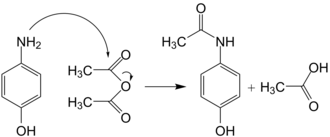Paracetamol
Paracetamol (or acetaminophen) is a common drug for relieving pain. It can also be used to reduce fever, or headache, caused by a cold or a flu.
Overview
The IUPAC name for paracetamol is acetaminophen.[7] Both acetaminophen and paracetamol both come from the names of the chemicals used in the compound: N-acetyl-para-aminophenol and para-acetyl-amino-phenol. Sometimes, it is shortened as APAP, for N-acetyl-para-aminophenol.
History
Harmon Northrop Morse was the first to make paracetamol, in the year 1878. Drugs made with paracetamol became common in the 1950s. Today, these drugs are some of the most used, together with those containing salicylic acid, Ibuprofen or Diclofenac. Unlike these, paracetamol has no anti-inflammatory properties. In the year 1977, paracetamol was added to the List of Essential Medicines of the WHO.
Safety
Paracetamol is considered safe for use. The drug is easily available without a prescription. Patients sometimes take too much paracetamol, when they do not know how much should be taken. The recommended dose may not work for some people. Other times, it is because they are trying to commit suicide. Very often, a person's liver can be hurt when they take too much paracetamol.[8]
A dose of 150 milligrams (mg) for every kilogram (kg) of the person's weight (about 10 grams for most adults) will lead to permanent liver damage, and may cause the liver to fail. For people whose livers have already been damaged, such as alcoholics, and for those with a limited secretion of paracetamol, this amount can be much smaller.[9]
United Kingdom
In England and Wales, about 30,000 people per year go to the hospital after taking too much paracetamol (called paracetamol poisoning), with about 150 dying of the poisoning. Since a law was passed saying that paracetamol packets cannot be too large, fewer people have been committing suicide with paracetamol.[10] In Great Britain[11] and the United States Paracetamol is the main reason for acute liver failure. About half of the cases are because of an "unintentional overdose".[8]
Mass poisoning incident in 1982
In 1982, there was a case of sabotage.[12][13] Packets of paracetamol had been tampered with: Seven people died, because they had taken poisoned samples. As a result, the FDA made stricter regulations. Also, paracetamol-products worth 100 million US dollars were called back.
Paracetamol Media
Julius Axelrod (pictured) and Bernard Brodie demonstrated that acetanilide and phenacetin are both metabolized to paracetamol, which is a better-tolerated analgesic.
Brown tree snake aerial bait cartridges consisting of dead mice with 80 mg paracetamol tablets
References
- ↑ Karthikeyan M, Glen RC, Bender A (2005). "General Melting Point Prediction Based on a Diverse Compound Data Set and Artificial Neural Networks". Journal of Chemical Information and Modeling. 45 (3): 581–590. doi:10.1021/ci0500132. PMID 15921448.
- ↑ "melting point data for paracetamol". Lxsrv7.oru.edu. Archived from the original on 30 June 2012. Retrieved 19 March 2011.
- ↑ 3.0 3.1 3.2 3.3 3.4 Granberg RA, Rasmuson AC (1999). "Solubility of paracetamol in pure solvents". Journal of Chemical & Engineering Data. 44 (6): 1391–95. doi:10.1021/je990124v.
- ↑ Working Group of the Australian and New Zealand College of Anaesthetists and Faculty of Pain Medicine (2015). Schug SA, Palmer GM, Scott DA, Halliwell R, Trinca J (eds.). Acute Pain Management: Scientific Evidence (4th ed.). Melbourne: Australian and New Zealand College of Anaesthetists (ANZCA), Faculty of Pain Medicine (FPM). ISBN 978-0-9873236-7-5. Archived from the original (PDF) on 31 July 2019. Retrieved 28 October 2019.
- ↑ 5.0 5.1 5.2 Forrest JA, Clements JA, Prescott LF (1982). "Clinical pharmacokinetics of paracetamol". Clin Pharmacokinet. 7 (2): 93–107. doi:10.2165/00003088-198207020-00001. PMID 7039926. S2CID 20946160.
- ↑ "Codapane Forte Paracetamol and codeine phosphate product information" (PDF). TGA eBusiness Services. Alphapharm Pty Limited. 29 April 2013. Archived from the original on 6 February 2016. Retrieved 10 May 2014.
- ↑ "Paracetamol Indications, Uses, Dosage, Drugs Interactions, Side effects". medicaldialogues.in. 31 May 2023. Retrieved 8 November 2024.
- ↑ 8.0 8.1 Larson A. M.; et al. (2005). "Acetaminophen-induced acute liver failure: results of a United States multicenter, prospective study". Hepatology. 42 (6): 1364–1372. doi:10.1002/hep.20948. PMID 16317692. S2CID 24758491.
- ↑
- Roberts, L. Jackson; Morrow, Jason D. (2001). "Analgesic-antipyretic and antiinflammatory agents and drugs employed in the treatment of gout". In Gilman, Alfred; Goodman, Louis Sanford; Hardman, Joel G.; Limbird, Lee E. (ed.). Goodman & Gilman's the pharmacological basis of therapeutics. New York: McGraw-Hill. pp. 687–732. ISBN 0-07-112432-2.
{{cite book}}: CS1 maint: multiple names: authors list (link) - Williams, Roger Lawrence; Jean-Pierre Benhamou; Lee, William Thomas (1997). Acute liver failure. Cambridge, UK: Cambridge University Press. ISBN 0-521-55381-4.
{{cite book}}: CS1 maint: multiple names: authors list (link) - "8 Paracetamol Guidelines for Patients". PR Fire. Archived from the original on 2021-01-24. Retrieved 2021-02-12.
- Roberts, L. Jackson; Morrow, Jason D. (2001). "Analgesic-antipyretic and antiinflammatory agents and drugs employed in the treatment of gout". In Gilman, Alfred; Goodman, Louis Sanford; Hardman, Joel G.; Limbird, Lee E. (ed.). Goodman & Gilman's the pharmacological basis of therapeutics. New York: McGraw-Hill. pp. 687–732. ISBN 0-07-112432-2.
- ↑ Morgan OW, Griffiths C, Majeed A (April 2007). "Interrupted time-series analysis of regulations to reduce paracetamol (acetaminophen) poisoning". PLOS Med. 4 (4): e105. doi:10.1371/journal.pmed.0040105. PMC 1845154. PMID 17407385.
{{cite journal}}: CS1 maint: multiple names: authors list (link) - ↑ Chun, L. J.; et al. (2009). "Acetaminophen hepatotoxicity and acute liver failure". J Clin Gastroenterol. 43 (4): 342–349. doi:10.1097/MCG.0b013e31818a3854. PMID 19169150.
- ↑ G. Dunea: Death over the counter. In: Br Med J. 1983, 286, pp. 211–212. PMID 6401533; Template:PMC.
- ↑ K. A. Wolnik, F. L. Fricke, E. Bonnin, C. M. Gaston, R. D. Satzger: The Tylenol tampering incident – tracing the source. In: Anal. Chem. 56, 1984, pp. 466A–470A, 474A. PMID 6711821.










